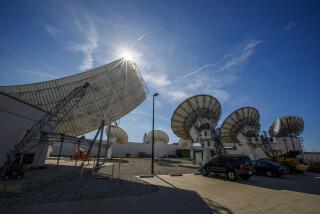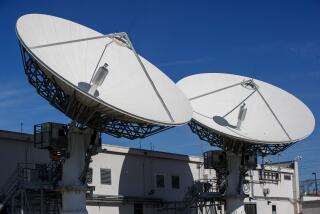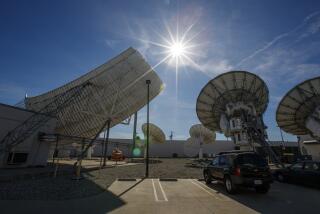Satellite Firms to Offer Local TV Channels
The nation’s two largest satellite TV services plan to offer a package of local broadcast channels in Los Angeles and New York this summer, giving customers the closest alternative yet to cable.
The move signals growing confidence that Congress and the president soon will approve legislation eliminating long-standing barriers to such services that have limited the appeal of satellite TV.
Armed with a complete set of both cable and local channels to offer subscribers, satellite TV services would be poised to mount their most significant challenge yet to the dominance of the cable industry in reaching American households.
DirecTV, the nation’s leading satellite television service, said Wednesday that it is prepared to offer the most popular local broadcast signals, including ABC, NBC, CBS and Fox, in the nation’s two largest cities initially, and in an additional 20 metropolitan areas later in the year. DirecTV is a unit of El Segundo-based Hughes Electronics Corp., which is a division of General Motors Corp.
Meanwhile, EchoStar Communications, the smaller rival of DirecTV, also has plans to offer local broadcast channels in 13 cities this summer, including Los Angeles and New York.
While these services will remain more expensive than cable because of the upfront equipment and installation costs, their ability to offer local broadcast networks that account for an estimated 60% of cable viewing should help expand their popularity. DirecTV and EchoStar together reach about 9 million subscribers, compared with the 65 million who buy cable services.
The cable industry is also rapidly changing, preparing to offer telephone and Internet services, analysts said. Cable has a technological advantage in offering a wider array of services that satellites can not. Still another barrier to growth for satellite services is the initial investment consumers must make for home equipment and installation.
The two satellite companies are able to expand their offerings because of widely anticipated changes in federal laws and pending acquisitions of additional satellite capacity.
Federal laws forbid the satellite delivery of local broadcast channels into local markets, putting the industry at a measurable disadvantage to cable operators. To view local broadcast channels, consumers must buy cable service or use TV antennas.
Congress has been eager to break cable’s monopoly over pay television, particularly now that federal regulations governing cable rates have been phased out.
To strengthen satellite competition against cable, the House of Representatives last month overwhelmingly passed legislation allowing satellite services to carry local broadcast channels. Congress is expected to sign off on new laws favorable to satellite television providers by the summer and President Clinton is expected to sign the measure.
Both DirecTV and EchoStar have been aggressively growing over the last six months in anticipation of the new laws and in a race against the cable industry. Cable operators are spending billions of dollars to upgrade their systems to provide new services such as high-speed Internet connections, telephone and digital video, and interactive television.
AT&T;’s recent cable-buying spree, including the purchase of Tele-Communications Inc. and the proposed acquisition of MediaOne Group, is part of the phone giant’s vision for offering consumers a convenient bundle of telecommunications and entertainment services over cable lines at one low price.
DirecTV and EchoStar are each also trying to round out their packages with Internet and interactive services, although analysts doubt that in the long term satellite will have the technological capacity to take on cable. While cable wires allow large amounts of information to be shipped in two directions on their networks, satellite transmission is largely a one-way medium, with slow telephone return lines.
Both DirecTV and EchoStar are trying to increase subscribers now, before cable is fully upgraded, on the premise that consumers hate to switch their television service if they have invested in expensive equipment. It now costs an average of $250 for installation and a DirecTV satellite dish and receiver, compared with $850 when the company introduced the service in 1994 in what was the most successful consumer electronics introduction in history.
DirecTV is somewhat sketchy about which local channels it will offer and at what prices. That is because Congress is still debating whether to require satellite services to carry every broadcast channel in a market to prevent them from cherry-picking the most popular channels to the detriment of smaller, independent stations.
Both satellite companies are pushing for legislation that allows them to offer only the most popular local channels in a market, arguing that neither has the capacity to offer all 1,600 broadcast stations nationwide in their lineups.
In Los Angeles, DirecTV says it will offer NBC, ABC, Fox and CBS, with the WB, UPN and KCAL stations still up for review. The company has not determined how much it will charge for the package of services, but industry analysts predicted a price in the neighborhood of $6 a month. DirecTV charges $29.99 a month for the most popular package of 60 channels.
EchoStar says it will charge $4.99 a month for a package of local channels, on top of the $19.99 it charges for a basic package of 40 channels.
The expanded basic cable services in Los Angeles range between $30 and $40 a month for a package of broadcast channels and the most popular cable networks.
While customers in Los Angeles and New York will be able to use existing equipment to receive the new local channels, those in other cities will have to purchase new equipment. That is because the signals will be transmitted from satellite transponders on a different orbital slot than DirecTV uses to send its core channel lineup. DirecTV says it will give existing customers discounts on new equipment, which includes a 22-inch dish that is required to see both satellites. The current dish is 18 inches.
DirecTV’s plan to use its satellite capacity to transmit local broadcast channels is a radical shift of strategy. EchoStar Chief Executive Charlie Ergen has been the biggest champion of legislative changes that would allow the industry to carry local signals, while DirecTV has maintained until recently that it is uneconomical to use its satellite capacity for transmitting local stations that they can charge little for.
DirecTV has contended that about 70% of the nation’s 100 million households can get the signals with a common over-the-air antenna. It is unclear whether its customers will be willing to pay for those channels now that the company has switched strategies, and whether either company can make the economics work.
Aggressive price discounting by EchoStar has dramatically reduced the monthly charges of satellite service, bringing them below cable in many cases. (Most households have more than one television, making satellite a costlier proposition when equipment costs are factored in. DirecTV charges an additional $4.99 a month for programming for an additional television set.) But many analysts doubt that rivals can keep on cutting rates as programming costs escalate.
Counting pending acquisitions, DirecTV will serve 7 million customers, while EchoStar supplies an additional 2.2 million. That is just a fraction of the 65 million households served by cable.
More to Read
The biggest entertainment stories
Get our big stories about Hollywood, film, television, music, arts, culture and more right in your inbox as soon as they publish.
You may occasionally receive promotional content from the Los Angeles Times.










